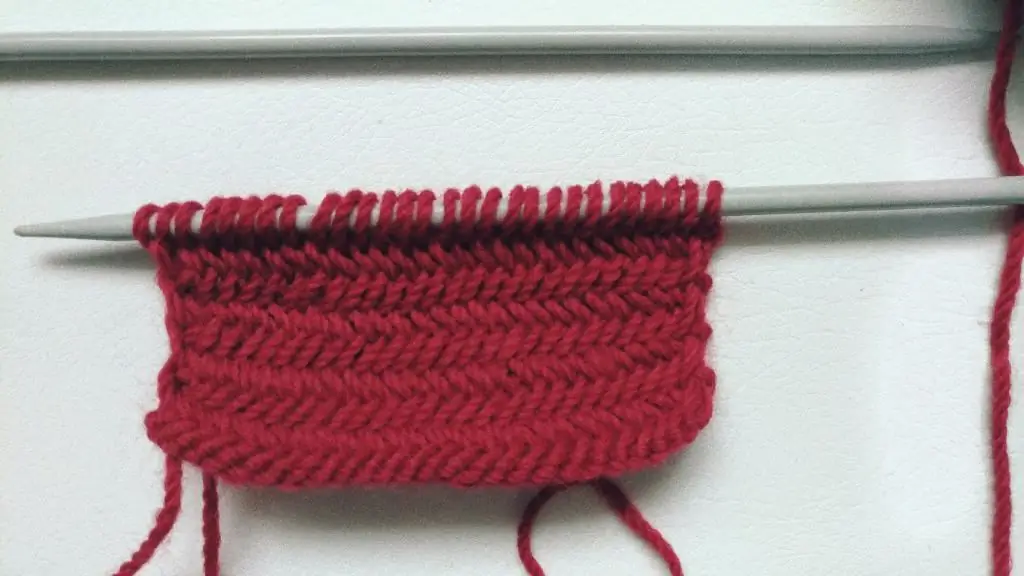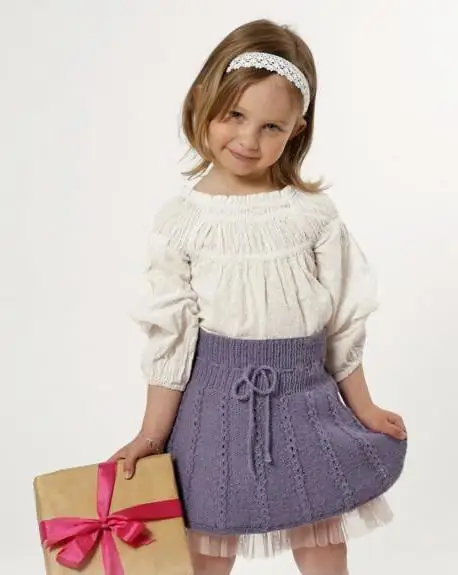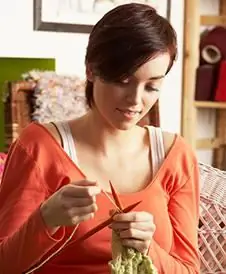
Inhaltsverzeichnis:
- Autor Sierra Becker [email protected].
- Public 2024-02-26 04:45.
- Zuletzt bearbeitet 2025-01-22 22:11.
Stricken ist ein modisches Handwerk, das seine Fans bis heute nicht verloren hat. Das Erstellen komplizierter Muster mit zwei Nadeln ist fast magisch. Das Fischgrätenmuster ist eines der häufigsten und interessantesten. Einfach und prägnant, wird es viele ansprechen. Und selbst wer noch ganz neu Stricknadeln in der Hand hält, beherrscht es.
Beschreibung des Fischgrätmusters
Es ist nicht schwierig, das benannte Muster (sein anderer Name ist "Ährchen") mit Stricknadeln zu stricken. Dies ist ein sehr dichtes, glattes einseitiges Muster. Es sieht aus wie kleine diagonale Stiche, die mit ihrer Anordnung einem Weihnachtsbaum ähneln. Der so gestrickte Stoff ist sehr dicht, mäßig elastisch und behält nach dem Waschen seine Form gut.
Meistens wird dies aus ziemlich dicken Wollfäden gestrickt, ohne die Maschen zu fest anzuziehen. Bei dieser Strickmethode mit Fischgrätmuster wird der Stoff strukturierter und voluminöser. "Ährchen" eignet sich perfekt zum Stricken eines Snoods oder eines engen Pullovers. Es sieht recht einfach und prägnant aus, daher wird es oft zum Stricken von Herrensachen verwendet.
Erste Reihe
Um das Fischgrätenmuster mit Stricknadeln zu stricken, können Sie wählenbeliebig viele Schleifen. Das Erscheinungsbild des Musters wird dadurch in keiner Weise beeinträchtigt. Um eine Probe zu machen, können Sie etwa 15-20 Maschen anschlagen (wenn der Stoff aus einem ausreichend dicken Garn gestrickt ist). Nachdem die erforderliche Anzahl Schlaufen angeschlagen wurde, können Sie mit der ersten Reihe fortfahren:
- Die erste Randmasche wird nicht gestrickt, sondern einfach auf die rechte Nadel verschoben.
- Dann müssen Sie mit der rechten Stricknadel gleichzeitig die nächsten beiden Schlaufen hinter die Rückwand hebeln und als Vorderwand stricken.

- Die erste gestrickte Masche muss von der linken Nadel fallen gelassen werden und die zweite von links. Und wiederholen Sie die vorherige Aktion erneut.
- Die verbleibende Masche wird mit der nächsten rechts zusammengestrickt.

- Eine der gestrickten Maschen fällt von der linken Nadel, die andere bleibt.
- Diese Aktion muss bis zum Ende der Zeile ausgeführt werden.

Die zuletzt verbleibende Masche wird als Vorderteil gestrickt
Erste Reihe Fischgrätmuster fertig!

Zweite Reihe
Die zweite Reihe wiederholt die erste fast vollständig, nur dass anstelle der vorderen Maschen links gestrickt werden muss:
- Die erste Randmasche wird von der linken auf die rechte Nadel verschoben, nicht gestrickt.
- Dann können Sie mit dem Muster selbst fortfahren. Es ist notwendig, die rechte Stricknadel direkt unter die nächsten beiden Maschen zu führen und sie als Links zusammenzustricken.

- Die letzte gestrickte Masche wird verworfen und die andere bleibt auf der linken Nadel.
- Dann müssen Sie die beiden äußersten Maschen auf der linken Nadel gleichzeitig mit der rechten Stricknadel einhaken und falsch verknoten.

- Eine der gestrickten Maschen wird verworfen und die andere bleibt wieder auf der linken Nadel.
- Und diese Aktion muss bis zum Ende der Zeile wiederholt werden.

- Die letzte auf der linken Nadel verbleibende Masche wird links gestrickt.
- Als nächstes sollten Sie die erste und zweite Reihe abwechselnd stricken.

Nachdem ca. 6-7 Reihen mit diesem Wechsel gestrickt sind, kann man bereits beurteilen, wie das Muster aussieht. Es sollte gleichmäßig sein.
Um den Stoff gleichmäßig und sauber zu machen, müssen Sie die Spannung des Fadens überwachen. Der Faden sollte gleichmäßig gespannt sein, die herauszuziehenden Schlaufen sollten gleich groß sein. Die Schlaufen sollten nicht zu eng, aber auch nicht zu locker sein. Sonst wird das so gestrickte Fischgrätmuster entweder zu dicht oder zu locker. Und die Schlaufen gleicher Größe und Spannung bilden eine gleichmäßige Leinwand.

Dies ist so ein schönes und gleichzeitig einfaches Muster, das Sie erstellen können. Nach sorgfältigem Lesen der Anleitung werden auch Anfänger die Aufgabe bewältigen.
Empfohlen:
Schöne und originelle Röcke für Mädchen mit Stricknadeln (mit Beschreibungen und Diagrammen). Wie man einen Rock für ein Mädchen mit Stricknadeln strickt (mit einer Beschreibung)

Für eine Handwerkerin, die mit Garn umgehen kann, ist es kein Problem, einen Rock für ein Mädchen mit Stricknadeln (mit oder ohne Beschreibung) zu stricken. Wenn das Modell relativ einfach ist, kann es in nur wenigen Tagen fertiggestellt werden
Wie man ein Sommerkleid für ein Mädchen mit Stricknadeln strickt und häkelt

Für eine Mutter gibt es nichts Angenehmeres, als ihr Baby mit Outfits „wie ein Erwachsener“zu erfreuen. Jetzt, wenn der Sommer vor der Tür steht, ist es an der Zeit, Ihre Garderobe mit leichter neuer Kleidung aufzufüllen, also werden wir analysieren, wie man ein Sommerkleid für ein Mädchen strickt
Wie fertigt man eine Mütze mit Stricknadeln? Wie man eine Mütze mit Stricknadeln strickt: Diagramme, Beschreibung, Muster

Stricken ist ein interessanter und aufregender Prozess, der lange Abende in Anspruch nehmen kann. Mit Hilfe des Strickens schaffen Handwerker wirklich einzigartige Werke. Aber wenn Sie sich unkonventionell kleiden möchten, müssen Sie lernen, wie man selbst strickt. Schauen wir uns zuerst an, wie man eine einfache Mütze strickt
Wie man ein Lätzchen bindet. Wie man eine Hemdfront für ein Kind strickt

Wenn die Kälte kommt und der Wind durchdringt, beginnst du darüber nachzudenken, wie du dich am besten aufwärmst. Wenn Sie ein Kind in den Kindergarten schicken, wickeln Sie seinen Kopf vollständig mit einem Schal ein und lassen nur seine Augen übrig. Wenn Sie die Gruppe betreten, sehen Sie, dass das Kind vereist und mit Eiszapfen bedeckt ist. Es ist sehr unangenehm. Wir bieten eine Alternative zu einem Schal. Ein großer warmer Kragen - ein Schal oder eine Hemdfront. Es stimmt, nicht jeder weiß, wie man eine Hemdfront bindet
Wie man einen Anzug für ein Neugeborenes mit Stricknadeln strickt: eine Meisterklasse

Ein Anzug für ein Neugeborenes, gestrickt, sollte schön und bequem sein. Es gibt viele Ideen, die Hauptsache ist, das Modell zu wählen, das ideal für das Baby ist, ihm Wärme und Komfort gibt
